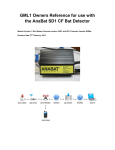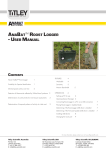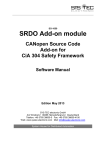Download GML1 User Manual for SD2 (146a V4R1 4061w)
Transcript
GML1 Owners Reference for use with the AnaBat SD2 CF Bat Detector Manual Version 1.46a, Modem Firmware Version V4R1 and SD2 Firmware Version 4061w Revision Date 6th August 2012 This manual should be used with the SD2 User Manual v1.8 or later 1 GML1 – Complete Users Manual TABLE OF CONTENTS Section 1. HARDWARE GUIDE...................................................................................... 2 Principles of operation ....................................................................................................... 3 Quick Start Notes – either system ..................................................................................... 5 Getting Started .................................................................................................................. 6 Configuring the Anabat SD2 CF Bat Detector ................................................................ 6 Checking the real time clock in Anabat SD2 CF Bat Detector ........................................ 6 Initialising the CF card ................................................................................................... 7 Recording some test data .............................................................................................. 7 Registering your new device .......................................................................................... 7 M2M DATA SIM Card Installation .................................................................................. 8 GML1 Configuration and Diagnostic Interrogation ............................................................. 9 Modem LED Indicators................................................................................................... 9 M2M data SIM Card Error .............................................................................................. 9 Carrier Error ................................................................................................................. 10 Carrier Network Detected............................................................................................. 10 Updating GML1 firmware ................................................................................................. 16 Technical specifications ................................................................................................... 21 Power supply requirements: ......................................................................................... 21 Power plug part numbers: ............................................................................................ 21 Antenna connectors ..................................................................................................... 21 RS232 cable: ............................................................................................................... 21 Section 2. ONLINE USER INTERFACE........................................................................ 22 Accessing Your Data ....................................................................................................... 23 Logging into your account ............................................................................................ 23 The initial login report screen ....................................................................................... 23 Adding new units to your account ................................................................................ 24 Interrogating a particular SD2 unit ................................................................................ 25 Change the operating parameters of a particular SD2 unit ........................................... 26 Accessing the downloaded files from a particular SD2 unit .......................................... 31 For firmware versions – GML1 Modem version V4R1, SD2 version 4061w 2 GML1 – Complete Users Manual Section 1. HARDWARE GUIDE The GML1 system is a GPRS based self contained data acquisition and transfer module that can be customized to fit almost any data logging device. The GML1 has a very low power usage making it the perfect choice for battery operated installations. Wherever there is GSM coverage the GML1 can be used to upload data from your data logging device to our central server giving you not only convenient access to your data and remote monitoring facilities, but also protecting your irretrievable data in catastrophic events such as the device being stolen or damaged. This manual is specifically written for applications where the GML1 is connected to, and uploading data from an AnaBat SD2 CF Bat Detector system. The instructions contained herein will take you through the entire processes necessary to configure both the GML1 and the AnaBat systems so that they will operate in the most effective manner possible. These instructions are for use with an AnaBat SD2 CF Bat Detector system. This system will be referred to as a ‘SD2’ system from here on. For firmware versions – GML1 Modem version V4R1, SD2 version 4061w 3 GML1 – Complete Users Manual Principles of operation The GML1 device, pictured below, operates on the GSM network using GPRS to transfer data over the Internet. Consequently you will need a GPRS enabled wireless machine-to-machine (M2M) DATA SIM card from a local telecommunication company that provides such coverage where your GML1 is installed. Depending on the signal strength (environmental conditions) you may also consider using a higher gain directional Yagi external antenna if you experience low signal strength at the GML1 site. The SD2’s serial port connects to the GML1’s serial port with the supplied serial cable. Once the GML1 has transmitted all of the data from the SD2 unit to www.getmylog.com Web Server on the Internet, you will be able to access this data (privately and securely maintained as just your data) using any computer connected to the Internet. For firmware versions – GML1 Modem version V4R1, SD2 version 4061w 4 GML1 – Complete Users Manual Principles of operation (cont.) A feature of the GML1 system is that you can send configuration commands to the GML1 using SMS messages from your mobile phone (see the illustration below). The GML1 system also tells you the battery voltage, you can set the sensitivity remotely and change the data division ratio. For firmware versions – GML1 Modem version V4R1, SD2 version 4061w 5 GML1 – Complete Users Manual Quick Start Notes – either system The following steps summarize the necessary steps required to get the GML1 up and running. For those of you who are new to the GML1, or who like detailed explanations, please refer to subsequent sections of this manual for very detailed explanations of the following steps. Note, however, that once you have followed the rest of the manual, you should none-the-less refer back here to verify that you have not missed or glossed over anything important. 1. Setup the software on your computer/laptop 2. Have a USB / Serial Port available for communications with the SD2 3. Have a Compact Flash reader / writer device connected and functioning 4. Program the SD2 4061w firmware into the SD2 5. Configure a Compact Flash (CF) memory card for the initial testing 6. Record some data onto the CF card for the initial testing 7. *Obtain a compatible M2M data SIM card for your area 8. Connect all cables to the GML1 and SD2 9. Ensure you have a compatible antenna connected to the GML1 unit 10. Connect the GML Monitor to the GML1 to enable debugging 11. Log into www.getmylog.com with your account details provided and use the ‘NEW DEVICE’ feature to add the serial number of the SD2 device to your account as per page 22 of this manual. Failure to do this will cause an unsuccessful connection to the getmylog server 12. Power on the GML1 unit 13. Send an SMS to configure the M2M data SIM card 14. Once the GML1 is configured and waiting for the SD2, power on the SD2 15. Check the GML1 monitor for the progress of transfer of data to the server 16. Once completed, log on to the server and check and download the transferred data 17. Disconnect the GML Monitor * Step 7 is the most difficult step. Note that you have to have an M2M DATA SIM Card. It is essential that first time users refer to the website for further details relevant to your region to source a compatible M2M DATA SIM Card. Pre-configured M2M DATA SIM Cards may be available at time of purchase. For firmware versions – GML1 Modem version V4R1, SD2 version 4061w 6 GML1 – Complete Users Manual Getting Started Firstly you need to verify that the location where the GML1 will reside has suitable GSM network coverage and source an appropriate GSM M2M DATA SIM card. Please note that some providers seem to have limitations on how much data can be uploaded (continuously) over the GPRS network (such as the prepaid Optus M2M DATA SIM cards in Australia). It is strongly recommended that you investigate all options available from all providers in the region and to choose the plan which has the least number of limitations on the transfer of data (in both directions). Cost is not always the best discriminator in these situations. If in doubt, just remember to ask the provider if the plan will allow you to upload at full speed around 20 Mbytes of data in, say, an 10 hour period without resetting or terminating the connection at set intervals (be such intervals data blocks or time segments). Configuring the Anabat SD2 CF Bat Detector The data recorded by an SD2 is stored on a configured Compact Flash memory card (referred to as the CF here on) in the SD2. The SD2 unit needs special firmware in order to communicate with the GML1 unit. See the SD2 User Manual for ‘HOW TO UPGRADE THE FIRMWARE’. The relevant firmware version for the SD2 is currently version 4061w, the ‘w’ implies the wireless GML1 version of the SD2 firmware. Checking the real time clock in Anabat SD2 CF Bat Detector Once the firmware has been upgraded it is a good idea to check for the correct time in the SD2. This is because the time zone where the system is being deployed may well be different to the time zone at the place of manufacture. See the SD2 User Manual for ‘HOW TO CHECK AND SET THE REAL TIME CLOCK IN THE SD2’. Please note that when you use CFCread to set the SD2 time it will be set to the date and time of the computer it is connected to. Consequently make sure the computer has the correct date and time set for the time zone that the GML1 will operate in. For firmware versions – GML1 Modem version V4R1, SD2 version 4061w 7 GML1 – Complete Users Manual Initialising the CF card As mentioned above, the Compact Flash Card is referred to as CF in the following instructions. See the SD2 User Manual for ‘FORMATTING CF CARDS’ and ‘HOW TO INITIALISE CF CARDS’. Recording some test data For a test ONLY, using the CFCread program set the ‘Monitoring begins at ...’ time to be say ½ hour from the current time and ‘Monitoring ends at ...’ time to be say 1 hour from the current time. This will give a ½ hour recording window (starting from the current time) to store data onto the CF card for a test of the transfer system. Left click on the ‘Erase’ button, this will store the programmed recording times onto the CF card for use in the SD2. The CFCread program should indicate ‘Disk Erased to Sector 1’. Remove the CF card from the CF reader / writer and insert the CF card into the SD2 while it is powered off. Power on the SD2 and the ‘Standby’ LED should light for approx 120 seconds before the SD2 powers off. The SD2 is now waiting for the programmed ‘Monitoring begins at ...’ time to wake up and start recording. At the ‘Monitoring ends at ...’ time after a further 120 seconds, the SD2 will shutoff waiting for the next day’s ‘Monitoring begins at ...’ time to recommence the recording cycle again. For this test at this point the CF card has data to transfer and the SD2 is now ready to connect to the GML1 system to transfer data to the server using the GSM GPRS mobile phone network. Registering your new device For the getmylog server to recognise your SD2 device, you must log into www.getylog.com with your account details provided, and use the ‘NEW DEVICE’ feature to add the serial number of the SD2 device to your account as per page 22 of this manual. Failure to do this will cause an unsuccessful connection to the getmylog server. For firmware versions – GML1 Modem version V4R1, SD2 version 4061w 8 GML1 – Complete Users Manual M2M DATA SIM Card Installation Make sure that the GML1 is powered down. Now insert the M2M DATA SIM card. To release or insert a M2M DATA SIM card you need to gently slide it into the slot (see the drawing on the side panel of GML1 for details on card orientation) and then press onto it gently, but firmly, until you hear a click sound. Once clicked in the card will be locked inside GML1. (To release the M2M DATA SIM card you simply push on its leading edge again and it will unlock and eject smoothly.) To move to the next step in setting up your GML1 device you need to connect a digital display interrogation unit (called the GML Monitor and shown in the following diagram) to complete initialization of the device. Plug the GML MONITOR cable into the GML1 AUX port and power up the GML1 unit. Wait a brief period for the device to respond and then follow the steps described in the next section to finalize the configuration of your GML1 unit. For firmware versions – GML1 Modem version V4R1, SD2 version 4061w 9 GML1 – Complete Users Manual GML1 Configuration and Diagnostic Interrogation After connecting the GML Monitor and powering up the GML1, you should see the following “WAITING FOR DEVICE” message displayed on the Monitor screen. GETMYLOG MONITOR Version 1.1 R2 WAITING FOR DEVICE If you freeze on this screen then check that you are connected to the SD2 and that the correct firmware has been loaded on both devices. Please email support if you need any further assistance. Modem LED Indicators When power is first applied to the modem, the RED ‘STATUS’ LED on the modem end panel flashes intermittently. The GREEN ‘PWR’ LED is not a POWER indication LED. It is driven by firmware inside the modem and is not lit initially, but lights after approximately 25 to 35 seconds from when power is applied to the modem. M2M data SIM Card Error If the GML1 cannot access your M2M data SIM card, or your M2M data SIM card is locked, you will see the following “SIM CARD ERROR” screen. SIM CARD ERROR NOT READY OR LOCKED 358280004082992V4R1D The 15 digit on the bottom line of the display is the IMEI number of the GML1 modem and is followed by the firmware version in the modem, this and the following screen shots are an example where an AT&T SIM is used with V4R1D firmware loaded for GML1 use in the USA or Canada and any other region using the same GSM bands. You can use a mobile phone to remove the M2M data SIM card lock and verify that the card is working. A typical menu input to disable the SIM PIN is as follows, this will vary between mobile phones though. Enter the menu system using the following path (Settings>Phone>SIM PIN>off) to disable the SIM PIN lock. For firmware versions – GML1 Modem version V4R1, SD2 version 4061w 10 GML1 – Complete Users Manual Carrier Error If your M2M data SIM card cannot find any networks to register you will see “Carrier not found” instead as shown below. CARRIER NOT FOUND 358280004082992V4R1D Carrier Network Detected If a valid service provider can be found (there is enough signal to connect to the GSM network supported by your M2M data SIM card) you will see the name of the network and its signal strength. If the GML1 was able to find a carrier it will give you an indication of its signal strength in dBm. You should position your antenna to achieve a signal of no less than -91 dBm (a signal of 95 dBm for example is a LOWER level signal then -91 dBm, a signal of -84 dBm for example is a STRONGER level signal then -91 dBm). Most (but possibly not all) service providers send signals such that the antenna should be pointing in a vertical orientation for the strongest signal. Contact Titley Scientific if you need assistance at any stage. GML1 will continue to operate at lower signal strengths however the transmission speed and stability of GPRS link may be adversely affected. CINGULAR -88dbm GPRS TEST ERROR WAITING FOR CONFIG 358280004082992V4R1D NOTE – The SIM card must have the access point name ‘Internet’ assigned to it by the network service provider of the SIM card. If this has not been done the SIM card will not connect to the Internet and will leave the system sitting at the error condition above. As soon as a carrier is found the unit will commence a GPRS test. If a GPRS connection cannot be established then it will wait for a valid configuration to be set. To do this, you need to provide the following details for your GPRS connection: access point name, user name, password This is easily done using any mobile phone to send the following SMS message to your GML1 unit phone number. For firmware versions – GML1 Modem version V4R1, SD2 version 4061w 11 GML1 – Complete Users Manual NOTE – The word ‘conf’ MUST be in lower case letters otherwise the configuration message will not be processed by the modem firmware correctly. This message only has to be sent once when setting up the GML1 system, or whenever you change the SIM card in the GML1 to use a SIM card from another service provider that has not been sent the configuration message in the format below. conf,access point name,user name,password For the region option ‘D - GMS 850MHz + PCS 1900MHz’ firmware being loaded into the GML1 modem which is for use in the USA and Canada and any other region using the same GSM bands, using an AT&T SIM configuration SMS would look like this: conf,isp.cingular Please note that many providers in Australia require only the access point name, which is usually “internet”. Thus in Australia your M2M data simple configuration SMS would look like this: conf,internet After you send the SMS you will need to wait for the GML1 to process the new configuration SMS and pass the initial GPRS test (please note that there may be delays, sometimes many minutes, in SMS communication if the GML1 is connected to a different provider than the mobile phone you are sending the SMS from). You may send the SMS configuration multiple times, however only the latest SMS will be used by the GML1 device. If you have purchased your own SIM Card, then you may have to discuss any issues you have (at this point) with the service provider. CINGULAR -88dbm AP: isp.cingular TESTING GPRS 358280004082992V4R1D After the initial GPRS test is successfully completed, GML1 will complete its boot sequence and switch to operational mode. If your SD2 is busy recording or not connected you will see the following “WAITING FOR SD1” message. CINGULAR -88dbm GPRS TEST OK WAITING FOR SD1 358280004082992V4R1D For firmware versions – GML1 Modem version V4R1, SD2 version 4061w 12 GML1 – Complete Users Manual When your SD2 unit enters Standby mode and has data stored on its CF memory card the GML1 will contact the server to download the latest device settings. If your SD2 unit is registered on the server you will see the “SETTINGS RECEIVED” message as below. CINGULAR -88dbm DOWNLOAD SETTINGS SETTINGS RECEIVED 358280004082992V4R1D If your SD2 unit is not registered or the server cannot be accessed you will see the “SERVER NO RESPONSE” message. To fix this error, you will need to ensure that your SD2 unit is registered on our server. CINGULAR -88dbm DOWNLOAD SETTINGS SERVER NO RESPONSE 358280004082992V4R1D After the latest settings are downloaded, the GML1 will send reports to the server and to the specified mobile phone by SMS. CINGULAR -88dbm SENDING SMS SMS FAILED 358280004082992V4R1D If you requested an SMS report the following message will be sent to the specified mobile phone. (If your M2M data SIM card does not allow SMS messages to be sent you will see a “SMS FAILED” message above.) The SMS will be in the form - SN:”Serial number”-“Stored data in kb”kb, BT:”Battery voltage”V, SE:”Sensitivity value”, DR:”Data division ratio” ,CS:”Chunk size in kb”kb For firmware versions – GML1 Modem version V4R1, SD2 version 4061w 13 GML1 – Complete Users Manual Regardless of your setting, a report will be sent to the server. In this report you will also see if the SMS report succeeded or failed. CINGULAR -88dbm SENDING REPORT REPORT FAILED 358280004082992V4R1D If report fails you will see a “REPORT FAILED” message, otherwise the GML1 will remember the time of the last successful report and wait another day before the next report is sent. If you selected to only receive reports, leaving all the data on the device, you will see the following message. CINGULAR -88dbm SENDING REPORT REPORT ONLY 358280004082992V4R1D If there is no data to upload you will see a “NO DATA” message and the SD2 will be instructed to sleep. When the SD2 enters sleep mode, you will see the following message: CINGULAR -88dbm DOWNLOAD SETTINGS SHOULD BE ASLEEP 358280004082992V4R1D If there is data on the GML1 and you selected one of the upload modes, the GML1 will contact the data storage server. If either the GPRS connection cannot be established or the data storage server is not responding, then the GML1 will wait a few seconds and try again. CINGULAR -88dbm STARTING UPLOAD DATA: 1622 kb 358280004082992V4R1D For firmware versions – GML1 Modem version V4R1, SD2 version 4061w 14 GML1 – Complete Users Manual The “BLOCK” message below indicates that data blocks are being sent to the storage server. Note that you will not be able to see upload progress of individual blocks on your GML Monitor, but you can see it on the getmylog.com website. CINGULAR -88dbm BLOCK 1 OF 2 DATA: 1622 kb 358280004082992V4R1D When GML1 moves to another block it will display the last block number that was successfully uploaded. CINGULAR -88dbm BLOCK 2 OF 2 BLOCK 1 SENT 358280004082992V4R1D If GML1 experiences any problems with SD2 connection the message “SD1R ERROR” will be displayed and next attempt will be executed shortly. CINGULAR -88dbm ERROR DETECTED SD1R ERROR - RETRY 358280004082992V4R1D If GML1 experiences any problems with either: GPRS, Internet or Server connection, the message “SRVT ERROR” will be displayed and next attempt will be executed shortly. CINGULAR -88dbm ERROR DETECTED SRVT ERROR - RETRY 358280004082992V4R1D For firmware versions – GML1 Modem version V4R1, SD2 version 4061w 15 GML1 – Complete Users Manual If the data upload is successfully completed, GML1 will erase the data stored on the CF card in the SD2. CINGULAR -88dbm UPLOAD COMPLETED ERASING SD1:12345 358280004082992V4R1D GML1 will also send a file assembly request after all blocks are successfully uploaded. If this request fails you will see an “ASSEMBLY FAILED” message and the file set will continue to appear as “INCOMPLETE” in your file list. This request will be repeated multiple times in case of communication failure. CINGULAR -88dbm UPLOAD COMPLETED ASSEMBLY FAILED 358280004082992V4R1D PLEASE REMEMBER TO DISCONNECT THE GML MONITOR! The GML Monitor is a vital diagnostic tool but it is not required for GML1 to operate. It also consumes more power than an idle GML1 unit. The GML Monitor should only be used to set up the GML1 unit and for initial testing. It is not designed to be permanently connected to your GML1. Accessing your data You can access your data on the getmylog.com website. This is covered in the second section of this manual. For firmware versions – GML1 Modem version V4R1, SD2 version 4061w 16 GML1 – Complete Users Manual Updating GML1 firmware The GML1 V4R1 Update Utility is a single EXE firmware update program designed specifically for GML1 devices. To program the firmware in the modem connect the GML1 unit to a spare serial port on your computer (you may use a USB to RS232 converter cable). After you run the V4R1 program and select the COM port from the drop down list please make sure that GML1 is powered down before clicking on the CONNECT button. In the example below COM1 port has been selected as the serial port connected to the GML1 unit. For firmware versions – GML1 Modem version V4R1, SD2 version 4061w 17 GML1 – Complete Users Manual The default region setting (A – GSM 900MHz + DCS 1800MHz) is that used in the Asia Pacific region. To use the GML1 system in the USA and Canada you need to change the region setting. To do this click on the blue selection tick at the right hand side of the region indication window. When you do this a selection screen will be displayed as below showing the currently selected region code. For firmware versions – GML1 Modem version V4R1, SD2 version 4061w 18 GML1 – Complete Users Manual If you wish to use this GML1 unit in the USA or CANADA, please click on the Select region option ‘D - GMS 850MHz + PCS 1900MHz’. The screen below should now be present indicating the new region band D which is suitable for use in the USA and Canada. The modem firmware is now ready to be sent to the GML1 modem. To do this power on the GML1 unit wait a couple of seconds and click on the UPDATE button shown above. The screen shot below shows the Select region option ‘D - GMS 850MHz + PCS 1900MHz’ firmware being loaded into the GML1 modem which is for use in the USA and Canada and any other region using the same GSM bands. For firmware versions – GML1 Modem version V4R1, SD2 version 4061w 19 GML1 – Complete Users Manual If GML1 fails to respond or some communication errors are detected, close the program and simply try again. If you continue to experience problems they may be related to your COM port hardware. You should try to update GML1 using another computer before sending it back for service. Unlike many other firmware update protocols GML1 is completely safe, you can experience a complete power failure in the middle of the update without damaging the GML1 unit. Obviously you will need to repeat the update process before the unit is fully operational. For firmware versions – GML1 Modem version V4R1, SD2 version 4061w 20 GML1 – Complete Users Manual After all GML1 updates are completes as shown above you will see a green bar across the bottom of the window, no error messages and GML1 will be automatically rebooted. If the GML Monitor is connected to the GML1 unit you will be able to verify the firmware version and region loaded into it. For the region option ‘D - GMS 850MHz + PCS 1900MHz’ firmware being loaded into the GML1 modem which is for use in the USA and Canada and any other region using the same GSM bands, using an AT&T SIM the message on the GML Monitor may look like below. CINGULAR -88dbm GPRS TEST OK WAITING FOR SD1 358280004082992V4R1D For the region option ‘A - GMS 900MHz + DCS 1800MHz’ firmware being loaded into the GML1 modem which is for use in the Asia Pacific region and any other region using the same GSM bands, using a VODAFONE SIM the message on the GML Monitor may look like below. AUS VODAFONE -88dbm GPRS TEST OK WAITING FOR SD1 358280004082992V4R1A For firmware versions – GML1 Modem version V4R1, SD2 version 4061w 21 GML1 – Complete Users Manual Technical specifications Power supply requirements: 8-24V 24V , 12mA @ idle without the GML1 monitor (22mA with the monitor attached and backlight OFF, 110mA with the backlight ON), 150mA @ 2W output (all testing was conducted on a 12V power supply) pply) Power plug part numbers: -Molex Molex 4 pin female connector (part no: 43025-0400) 43025 -Molex Molex female tin plated crimp terminals (part no: 43030-0001) 43030 See the drawing above for polarity (note only 2 pins need to be connected) Included in the distribution on CD is a wiring diagram GML System Power Wiring.pdf which details the wiring for a 2 wire and 4 wire power cable. The 4 wire moulded cable has 2 wires which are not used for the GML system at present. Antenna connectors You will need a quad-band band GSM antenna antenna with a SMA Male connector (note some antennas sourced in Australia are only dual-band dual band and may not be suitable for use in the USA or CANADA). In some remote areas you may need to purchase a high gain antenna. Although more expensive than the smaller ones ones (that work OK in regional areas), the high gain antennae are especially suitable in remote and rural areas as well as in certain environmental setups (for example, in a deep gully in the outback surrounded by high iron ore bearing cliff faces). RS232 cable: The SD2’s serial port connects to the GML1’s serial port with the supplied serial cable. For firmware versions – GML1 Modem version V4R1, SD2 version 4061w 22 GML1 – Complete Users Manual Section 2. ONLINE USER INTERFACE This section introduces you to the management of your online data. It takes you through the steps to log onto the server and then how to download the data from the server to your local PC. Note this interface was designed to be as simple as possible, with maximum automation behind the scenes. Consequently the information and screens displayed are easy to navigate and manipulate. It typically takes only a few minutes to familiarize yourself with the operations available to you on the Web. For firmware versions – GML1 Modem version V4R1, SD2 version 4061w 23 GML1 – Complete Users Manual Accessing Your Data The data from your SD2 will be uploaded to the server as described in the previous section. Naturally you will want to access that data, your data, at appropriate intervals or, quite often just check on the status of the dataset that has accumulated on the server. The first step to gaining access to the uploaded SD2 data is to log in. Logging into your account When you received your GML1 hardware, you would have been supplied with a user name and password for your account. Start by going to the getmylog.com website and entering your user name and password into the following screen: If you made a mistake, then the following message will appear. Simply click on the Try Again button to repeat the login process. If you have entered the correct username and password, but get the following message, then your account has been suspended. In this case you will need to contact the GML system administrator to determine the reason. Only the system administrator can activate your account once it has been suspended. The initial login report screen After login you will see the following screen. This screen shows reports that cover the last 24 hours. Each report is for one of the SD2 units registered on your account. Thus these reports cover all activity across all the SD2 units associated with this login. For firmware versions – GML1 Modem version V4R1, SD2 version 4061w 24 GML1 – Complete Users Manual Units which failed to report within the last 24 hours will be highlighted. To access any unit simply click on its serial number (hyperlink). For demonstration purposes only, the screen shot above shows an early version of GML1 firmware (V3R3) in the ‘Ver’ column of the report. Adding new units to your account To register a new SD2 unit to your account click on the ‘NEW DEVICE’ button. This screen below allows you to register a new unit. Please note that the ‘NEW DEVICE’ button will not be active if you have already reached your limit of units that can be assigned to your account. If you need to increase this limit then please contact the system administrator to upgrade your subscription. Make sure that you enter the serial number correctly including all digits. If not the SD2 unit in the field will not be able to connect and upload it’s data. For firmware versions – GML1 Modem version V4R1, SD2 version 4061w 25 GML1 – Complete Users Manual To allow for the correct maintenance of historical data, please note carefully that this operation (of adding a new SD2 unit) can not be undone. Once you have created the new device, you will not be able to de-register this unit from your account. So, again, please ensure that you have entered all data correctly and verify each and every field entered before creating the device. The GML administrator can however transfer serial numbers from one user account to another user account in the case that the SD2 has been sold or transferred to another user. If the server detects any problems with the registration information entered, then you will see an error message explaining which fields are not filled out correctly. Please note that this is not a perfect error detection system and thus, as above, you are ultimately responsible for entering the correct data into the correct fields. Immediately after you register your new device it will appear in the devices list and your SD2 unit in the field will be able to start uploading data. Interrogating a particular SD2 unit After logging in, on the Recent activity report screen shown previously, click on the Serial Number of the SD2 you wish to view and you will see the Complete activity report showing the last 100 reports received from this GML1. The operating parameters read from the SD2 are shown in fields labelled - Data is in Kb, Battery in Volts, Div is Data Division Ratio either 16, 8 or 4. Sens is Sensitivity as a percentage from 0 to 100. SMS Phone is self explanatory, Chunk Size in multiplication of 512 bytes. For demonstration purposes only, the screen shot below shows an early version (V3R3) of GML1 firmware in the ‘Ver’ column of the report. NOTE - Modem firmware version V4R0/U and later – the Date & Time shown on all the report screens is now the date and time from the SD2 unit connected to GML1, so the report now displays the local date and time of the SD2 unit when the GML1 contacted the server. Previous versions (V3R8/U and earlier) displayed the date and time at the server (GMT+10) when the GML1 contacted the server. Any downloaded files are named using the date and time from the SD2 unit connected to GML1. For firmware versions – GML1 Modem version V4R1, SD2 version 4061w 26 GML1 – Complete Users Manual Change the operating parameters of a particular SD2 unit If you wish to change the settings for this unit fill out the above form on the right side and when all the required parameter changes are done, click the ‘Update’ button. You will see the result of your request displayed below the ‘Update’ button. This action will transfer the new parameters to the GML1 next time it contacts the server. There are 8 parameters that can be controlled by the user and these are detailed below, each parameter has a number of settings available. 1. ‘Mode’ Each of the modes below takes effect at the end of the next SD2 recording session. a. Report Only – tells the GML1 to ONLY send a report to the getmylog.com server, no upload of data occurs, no SMS is sent. b. Report + Upload – tells the GML1 to send a report to the getmylog.com server and upload any recorded data, no SMS is sent. c. Report + SMS – tells the GML1 to send a report to the getmylog.com server AND an SMS to the mobile phone number appearing in the ‘Send SMS to’ selection window, no upload of data occurs. d. Report + Upload + SMS – tells the GML1 to send a report to the getmylog.com server AND an SMS to the mobile phone number appearing in the ‘Send SMS to’ selection window. The GML1 will also upload any recorded data. 2. ‘Suspended’ When an SD2 device is not connected to a GML1, it is best to change the status of the SD2 to Suspended. If you tick the ‘Suspended’ check box, the SD2 serial number will appear in the list of devices in the ‘Suspended’ section of the Recent activity report page. Suspended status prevents the SD2 serial number appearing in the list of devices in the ‘No report from’ section of the Recent activity report page. Any devices listed in the ‘No report from’ section of the Recent activity report page are assumed to be Active but have not contacted the server within the last 24 hours, so these devices should be checked. This method is used as a ‘heartbeat’ indicator to tell you the operational status of each GML1 unit on a daily basis. 3. ‘Send SMS to’ Enter the mobile phone number that you wish to send an SMS report to (if that operating mode is selected). Note use only numerals and don’t include any spaces or hyphens. For firmware versions – GML1 Modem version V4R1, SD2 version 4061w 27 GML1 – Complete Users Manual 4. ‘Division Ratio’ The Data division ratio controls the resolution and thus the amount of data for a given recorded call. There are 3 available Data Division ratios, 16, 8 and 4 A Data division ratio of 4 provides finer resolution in the call than 16 but requires four times as much data to store the same call A Data division ratio of 4 is best used for lower frequency calls or sites where you don’t get large amounts of data which may prevent the system from uploading a complete night’s recording the following day 5. ‘Sensitivity’ The SD2 uses a Sensitivity control to optimise the recording of calls. If this control is set too high then electronic static, undesired noise from the wind, insects or other forms of ultrasonic noise will be recorded, leading to a large data file being uploaded to the server. Large data files can prevent a single night’s recording session being sent to the server the following day, possibly taking multiple days according to the size of the data file. If this control is set too low then you risk not detecting the available bat calls within range of the SD2. The value entered into the Sensitivity selection window on the Complete activity report controls 2 modes of operation of the SD2 Sensitivity function. a. A value of 0 (‘Manual’ mode) tells the SD2 to use its own front panel Sensitivity control. In this 0 = ‘Manual’ mode, the value reported in the ‘Sens’ column of the Complete activity report represents the mechanical position of the SD2 front panel Sensitivity control, where 1 represents the minimum Sensitivity value ie. 0% (fully counter clockwise) and 9 is the maximum Sensitivity value ie. 100% (fully clockwise). Note - at a Sensitivity value of 100% the SD2 would produce a lot of data due to detecting electronic static and should never be used at this setting. b. Any other value of 1 to 100 (‘Server’ mode) tells the SD2 to use this 1 to 100 value ignoring the SD2’s own front panel Sensitivity control. This function thus gives you remote control of the SD2 Sensitivity control. In ‘Server’ mode the value entered into the Sensitivity selection window on the Complete activity report represents a percentage from 1% to 100%, where 1% is the minimum Sensitivity value and 100% is the maximum Sensitivity value. The ‘Server’ mode value (1 to 100) will also appear in the ‘Sens’ column of the Complete activity report. For firmware versions – GML1 Modem version V4R1, SD2 version 4061w 28 GML1 – Complete Users Manual Note - at a Sensitivity value of 100% the SD2 would produce a lot of data due to detecting electronic static and should never be used at this setting. Any ‘Server’ mode Sensitivity value should only be set by an expert user who has prior familiarity with the Sensitivity setting. Sensitivity conversion table As a guide to how the scale on the SD2 front panel Sensitivity control converts to a percentage the following table may assist you. Please note there will be minor manufacturing variations between SD2 units that may lead to a slight variation of the numbers used on your particular SD2 unit. The GML1 V4R1 firmware converts the mechanical position of the front panel SENSITIVITY scale (1 to 9) to a number between 0 and 100. The table below is an approximation of the scale value displayed or entered to control the function, converting mechanical position to percentage using a logarithmic correction curve. Label setting Sensitivity as a percentage in 0% to 100% range 1 1 2 3 3 7 4 15 5 22 6 29 7 59 8 87 9 100 As an example you may see a value of 59% displayed in the Sens column on the Complete activity report. This approximates to a setting of around 7 on the front panel Sensitivity control Use the table above should you wish to remotely control the SENSITIVITY function of the SD2. 6. ‘Chunk Size’ This value is multiplied by 512 bytes to determine the size of the individual parts that a large data file is uploaded to the server. It is recommended for now that the value in this selection window be left at 1953, the default value. Too smaller value will increase the time taken to upload a complete data file, so please consult with Titley Scientific before altering this value. It is used to optimise the upload performance and should not be altered unnecessarily. For firmware versions – GML1 Modem version V4R1, SD2 version 4061w 29 GML1 – Complete Users Manual 7. ‘Update’ The ‘Update’ function is used to transfer any new parameters to the GML1 next time it contacts the server. When all the required parameter changes are done, click the ‘Update’ button. You will see the result of your request displayed below the ‘Update’ button. 8. ‘Delete Data’ This is a new function only available with GML firmware versions V4R0/U and later. This function is used to correct situations where excessive data has been recorded due to external influences or incorrect setup values and allows the GML system to erase the large data file from the CF card in the SD2 without having to upload the data file to the server. A large data file, for example 200MB of data may take several days to upload and if the information in the data file is useless because of recording or environmental conditions, then you may wish to not upload this data set. You must exercise extreme caution if you elect to use the ‘Delete Data’ function as outlined below. This is a non recoverable procedure and if you proceed with this function your data will be erased from the CF card in the SD2 To delete all data on a device click on the ‘Delete Data’ button on the bottom RHS. A confirmation screen as shown below will appear explaining the consequences and firmware requirements. If the ‘Delete Data’ function is used on GML1 firmware V3R8/U or earlier, it will have no effect on the device. A ‘Data deletion scheduled’ message will still appear on the device screen until the current file is completed and then it will disappear. For firmware versions – GML1 Modem version V4R1, SD2 version 4061w 30 GML1 – Complete Users Manual Clicking on the ‘CANCEL’ text brings returns you to the Complete activity report screen. Clicking on the ‘I UNDERSTAND ..’ link schedules the data deletion procedure and brings the following confirmation screen. Clicking on the ‘RETURN’ text returns you to the Complete activity report screen showing a red label in the right bottom corner indicating ‘Data deletion scheduled’. The ‘Delete Data’ button will be hidden as shown below. After the scheduled delete is executed (which is the next time the GML unit contacts the server) the red label (Data deletion scheduled) will disappear and the button ‘Delete Data’ will become visible again. If there are any partial uploads related to the deleted data file they will now be accessible on the download screen as shown below. As an example Device 04446 is used for the screen shot below. For firmware versions – GML1 Modem version V4R1, SD2 version 4061w 31 GML1 – Complete Users Manual When downloading or removing a partially uploaded file the GML server will still indicate missing parts (chunks) of the data file, for example: 090822_1429_1_4 090822_1429_2_4 090822_1429_3_4 ERROR PART 4 NOT FOUND Nonetheless, all available data will be combined into a single file that can be downloaded by the user. Partially uploaded files are also backed up before removal from the server and thus accessible by the System Administrator. Accessing the downloaded files from a particular SD2 unit To access the files downloaded by this unit click on the ‘DOWNLOAD’ button shown below. The examples below show files downloaded from SD2 Serial Number 01181 You will see the list of all files uploaded by this unit, only the completed files can be downloaded. If an Incomplete file is still being uploaded you can monitor its progress both by size and number of chunks already uploaded (click the Refresh button on your Web browser to see any changes). For firmware versions – GML1 Modem version V4R1, SD2 version 4061w 32 GML1 – Complete Users Manual Click on the File name required to start the download process. The example below shows a multi chunk download from SD2 01181 which finished recording at 11:30AM 2nd July 2009. All of the chunks of the selected data file will be automatically assembled into a single file that you can download by clicking on the ‘DOWNLOAD ..’ text on the above screen and you will be presented with another Windows screen as below. Click on the ‘Save’ button and another Windows screen will present itself as below. For firmware versions – GML1 Modem version V4R1, SD2 version 4061w 33 GML1 – Complete Users Manual Navigate to the folder you wish to save the download file and then click the ‘Save’ button, the example above will save the data file to a folder ‘Bat Files’. Once the download is complete, you will return to the screen below. Click on the ‘RETURN’ text to take you back to the list of files available for download as below. For firmware versions – GML1 Modem version V4R1, SD2 version 4061w 34 GML1 – Complete Users Manual If you wish to delete any files listed click on the ‘Remove’ text associated with the selected file to delete and the following confirmation screen will appear. Please note that once file is deleted from the server it is gone forever. You can return to the previous screen as shown below by clicking on the ‘RETURN’ text. You will notice that the file 090629_1540 now does not appear in the list of files available for download. You can return to the Complete activity report screen as shown below by clicking on the ‘RETURN’ text. Clicking on the ‘LOG OUT’ button terminates your connection with the getmylog.com server. For firmware versions – GML1 Modem version V4R1, SD2 version 4061w











































![Roostloggers [Titley] - An Introductory Manual](http://vs1.manualzilla.com/store/data/005649014_1-8c618e497bb2550a491bca85d50a292e-150x150.png)


